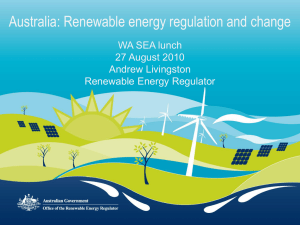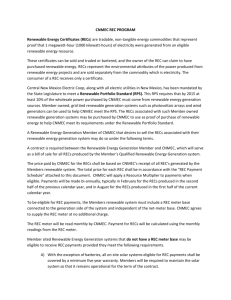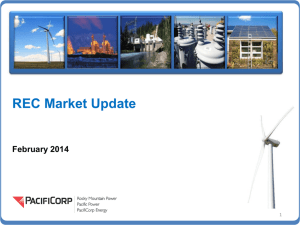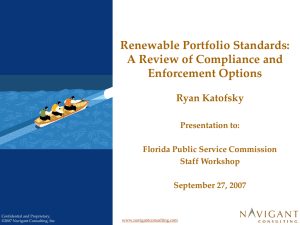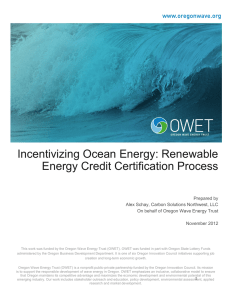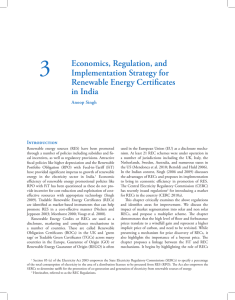Developing Successful Markets for Green Tags
advertisement
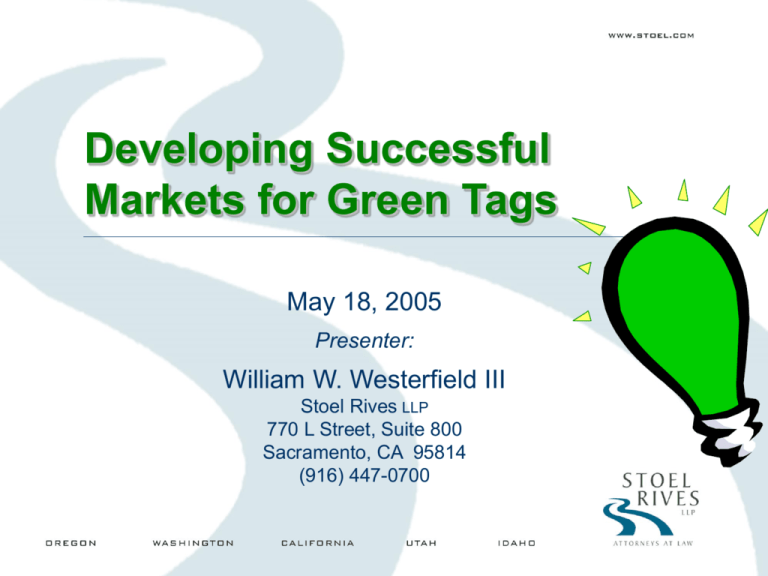
Developing Successful Markets for Green Tags May 18, 2005 Presenter: William W. Westerfield III Stoel Rives LLP 770 L Street, Suite 800 Sacramento, CA 95814 (916) 447-0700 What is a Green Tag? Production of Electricity from Renewable Energy Renewable Attributes Commodity Electricity Electricity generated from renewable energy can be divided into two distinct commodities – the electricity and the associated renewable attributes. Green Tags or Renewable Energy Certificates (RECs) represent the renewable attributes. If RECs are “unbundled” from the physical electricity, the two products may be sold or traded separately. RECs are a means to facilitate markets for renewable energy. 2 Market Value of RECs • Compliance Markets – to meet state regulatory requirements, such as renewable portfolio standards (RPS); and • Voluntary Markets – to allow consumers to buy renewable energy products, as in green pricing programs. Estimated REC Market Size and Value in 2004 and 2010 Compliance Markets Voluntary Markets Total Current REC Market Size (million MWh) Current REC Market Value ($millions) 2010 REC Market Size (million MWh) 2010 REC Market Value ($millions) 8-13 $140 45 $600 3 $15-$45 20 $100-$300 11-16 $155-$185 65 $700-$900 NREL Technical Report (Jan. 2005) 3 REC Products in the Marketplace • Compliance with RPS • Green Power - Rebundling for retails sales • Retail RECs (Regional) • Retail RECs (National) • Forward selling • Aggregation from small systems 4 Challenges for Developing Markets • Defining RECs • Improving REC Liquidity • Establishing Verification and Tracking Systems • Resolving Ownership Issues • Using RECs for Project Financing 5 Managing Different Definitions • Consensus: A REC is proof of 1 MWh of renewable generation such as wind, solar or biomass. • Inconsistencies in Product Definitions: – RECs vary by resource type, location and “vintage.” – Eligibility varies between states, tracking systems and voluntary certifying organizations. • Issue: Should “renewable attributes” include environmental attributes? – MAJORITY VIEW: Yes, should include factors such as avoided emissions of air pollutants and greenhouse gases. – MINORITY VIEW: No, disaggregation of attributes enhances value and promotes liquidity. 6 Improving Liquidity REC markets aim for greater liquidity, or enough buyers and sellers to assure a ready market with competitive prices. Factors bearing on liquidity: • Standardize Definitions: Differences in eligibility criteria for RPS compliance markets and definitions in voluntary markets make RECs less fungible and illiquid. • Extend Vintage: Longer life spans and forward markets have helped. • Connect Markets: Tension exists between larger, more liquid markets and public policy goals to encourage local benefits. 7 Better Tracking Makes Better Markets • Tracking systems are used to verify compliance with state RPS requirements, prevent double counting and prove green marketing claims. Tracking systems are infrastructure, not market platforms. • Current Issues: - Multiple tracking systems lead to fractured markets and integration issues - Who pays for tracking? States, utilities, generators, marketers? - What information should be included on a REC? - Gaming 8 Ownership Issues • Do payments for renewable energy or for renewable energy systems convey rights to RECs that are produced? • Are RECs transferred to utilities under long-term PURPA contracts? - FERC says transfer of RECs is a matter of state law; states have made different rules. • Are RECs transferred from customer-owned systems to utilities under net-metering and interconnection rules? • Are funders entitled to RECs in return for providing a subsidy to a customer-owned system? 9 Using RECs for Project Financing • RECs can provide significant, though uncertain, revenues for project financing. • Options to enhance and ensure REC value: - RECs generated from the project can be sold under longterm contracts to creditworthy buyers, e.g., University of Pennsylvania. - State renewable energy funds could buy RECs at a minimum price on a long-term basis, e.g., Massachusetts Renewable Energy Trust. - States can require long-term contracts for RECs or renewable power to satisfy RPS, e.g., California PUC. 10
